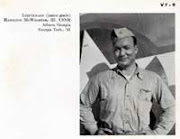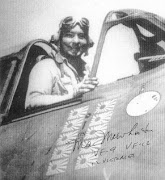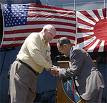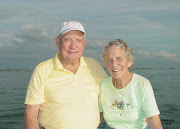Tuesday, May 13, 2008
Jay Stout
the great World War II historian, was also there and suggested that I ask Mac
if he'd like to get together to write his story. Well, I put my pitch
together and talked for about five minutes straight. Mac just replied in
typical, understated, no-words-wasted Mac fashion: "Sure."
That was the start of a wonderful working relationship. I spent a lot of
great weekend afternoons with Mac. They were made that much more enjoyable
when Louise visited with us.
As I mentioned earlier, Mac was a man of few words—especially when it came
to talking about himself. It was something we had to work around. I used to
tell him, "Mac, humility is a wonderful attribute, but the book's only going
to be fourteen pages unless you talk at least a little bit about yourself!"
In the end he came through, and his modesty was still apparent in the book.
At any rate, I really enjoyed working with him. He worked hard and honest,
and was a fine writer. I'm very proud that Mac—who had seen and done so
much—liked me.
Physically, Mac was the classic gentle giant. He had hands like a baseball
glove—big and rough. And an iron grip all the way to the end. But he never
showed off with that massive strength. A person just knew it was there. I
liked that about Mac.
And I'll miss him.
Mac recounts a battle victory
"We were orbiting at 12,000 feet on combat air patrol, when we were given a vector to intercept four bogies at twenty-thousand-plus. We applied full power and started climbing. By the time we got to 20,000, I spotted a single airplane ahead at 24,000, just making a bit of a contrail. I was climbing faster than the others in the division, and hit the water injection to catch up to him. I was right up on him at six o-clock and about one hundred feet below when I opened fire. He never made a move, but the engine went up and then his fuel tank caught. I was so close when he blew up that I had his engine oil all over the canopy. He went straight in as a fireball all the way down."
The date was May 12, 1945 - the Myrt was McWhorter's twelfth and final victory of the war.
Dad's Obit
From that moment, he knew he never wanted to do anything else.
The future Navy commander was a naval aviation cadet undergoing training when Pearl Harbor was attacked. Within a couple of years he had become the first American pilot to achieve “Ace” status flying a new airplane, the Hellcat.
By May 1945, he had shot down at least 12 Japanese planes and escaped danger on several occasions. In a book he wrote more than 50 years later, retired Cmdr. McWhorter recounted his war experiences, including battles over North Africa and the Pacific.
Cmdr. McWhorter died of natural causes April 12 at his home in El Cajon. He was 87.
His wife, Louise, said he loved flying and that was a big reason he made a career in the Navy. He later taught three of their five children to fly and after retiring from the Navy, he became a flight instructor at Gillespie Field.
“He was so proud that so many of his students became airline pilots,” she said.
Cmdr. McWhorter didn't talk much about the war to his family until he joined other fighter aces and started touring air shows where the members of the “greatest generation” shared their experiences.
Cmdr. McWhorter was born Feb. 8, 1921, in Athens, Ga., to Hamilton McWhorter Jr. and Nettie Lou Peurifoy McWhorter.
He met his future wife in November 1942 in Norfolk, Va., at a party thrown for a friend who had been shot down over the Atlantic during the invasion of North Africa. The friend had been reported dead, but when his friends found out he had been rescued, they threw a resurrection party.
Eight weeks later, Louise and “Mac” McWhorter were married. The couple had five children and later opened their home to a struggling Chinese immigrant family for a few years.
Cmdr. McWhorter was a member of the American Fighter Aces Association, the Distinguished Flying Cross Society and the Tailhook Association. He received several military honors including five Distinguished Cross Medals. Cmdr. McWhorter was elected to the Georgia Aviation Hall of Fame in 1989.
The family moved to El Cajon in 1968, and he retired as the executive officer of Naval Air Station, Miramar in 1969. Cmdr. McWhorter spent the ensuing years as a “gentleman farmer” tending to avocado trees at the family's home, as a flight instructor and an author.
He coauthored a book, “The First Hellcat Ace,” that was published in 2001. In 2006, Cmdr. McWhorter was interviewed for a History Channel segment on dogfights.
Besides his wife, survivors include sons, Donald of Lemon Grove, William of El Cajon, Hamilton IV of San Diego and Jon of San Diego; daughter, Georgia Scheingross of San Diego; and six grandchildren.
A memorial service is scheduled for 4 p.m. Sunday at First United Methodist Church of El Cajon. Ashes will be interred at 1 p.m. May 5 at Fort Rosecrans National Cemetery.
Donations are suggested to the Navy-Marine Corps Relief Society.















No comments:
Post a Comment